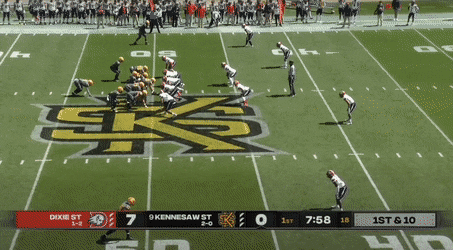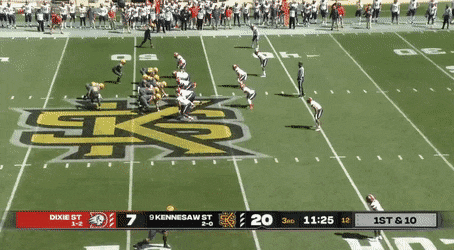There wasn’t a ton of super intriguing FCS action this weekend (and I’ll be honest, football wasn’t my top priority this weekend), so I figured that we can just take a look at the football scheme version of my comfort food today: the triple option. I’ve written about all sorts of triple option before and am not shy about my affinity for the system, and Kennesaw State’s version of it caught my eye. Let’s break it down.
The biggest thing that stands out about the Kennesaw State option attack is the quarterback footwork. When operating in a flexbone option like the Owls do, there are only so many things that you can modify and quarterback footwork is one of them. The differences aren’t huge, but there are differences in the footwork among the Army triple, the Navy triple, the Air Force triple and the Kennesaw State triple. Ken Niumatalolo’s Navy likes its quarterbacks to play as decisively as possible, getting right into reads to prevent the defense getting fully set at the start of the play, which means no delay from the snap. Navy’s quarterbacks are full speed as soon as they get the ball.
Kennesaw State doesn’t do that. Owl quarterback Tommy Bryant is much more deliberate about his footwork, taking his time specifically to force the defense into declaring its intentions, making the reads more obvious while allowing more time for the offensive line to set up its blocks. It’s almost like the triple option version of Wake Forest’s very long mesh point in the zone read game, which is designed around the idea that college defenders are impatient and will make the reads for your quarterback if given enough time. Bryant drops much deeper than usual on the snap, making the defensive end decide to bite in or stay while dragging linebackers further inside, creating more room on the outside on a pitch like this. You’re condensing the defense and then attacking it to the sidelines with speed, essentially.
This makes a lot of sense from Kennesaw State because almost its entire staff, led by head coach Brian Bohannon, has Paul Johnson ties and Johnson loved this approach. The quicker option attacks can bust bigger plays when the defense isn’t ready, but can also make things much harder on a quarterback. This approach is going to yield fewer huge runs but will make the offense far more efficient and much more difficult to land big plays against, usually in the form of TFL. You aren’t getting this group in the backfield unless something has gone seriously wrong.
Kennesaw State likes to pair that delayed read with plays like this one that have multiple lead blockers, allowing those blockers time to set up an inside seal, creating a very easy lane for the pitch man to get to the sidelines. The longer the quarterback has the ball, the further defense is going to contract and the easier it’ll be to set up that seal to make room on the outside. The cornerback bites in here to stop the quarterback, coming right to the lead blocker tasked with taking him out of the play. It allows for any pulling linemen to get to the perimeter as well, which is pretty crucial when you lack the kind of offensive line athletes available to a larger triple school like Navy or Army.
When the defense picks up on this and stops focusing so much on the quarterback, he’s able to then use that pause to manipulate the defense, waiting for it to sell out to stop the pitch man and creating his own lane just by forcing the defense to announce its intention.
The Owls lean into this with designed decoys, too. The flexbone lends itself well to pre-snap motion, either as full orbit motion that can get the offense an extra lead blocker or a pitch man with momentum, or as a fake to hold those linebackers in the box for an extra second which, when paired with the dive read at the start of the play, can really suck a defense in an make more room on the outside, leaving edge defenders and cornerbacks in really difficult spots against halfbacks in open space.
You get one of those decoys here, with the play side slot back selling motion into the backfield before cutting back out as the lead blocker, giving him some extra speed to take on the cornerback. The quarterback reads the unblocked edge defender for the dive, sees him bite inside and pulls the ball, making a quick pitch to his back side slot back when the second read, the play side safety, plays it too aggressively and shoots the inside gap, creating that outside lane.
Other times, they’ll use that motion almost like an influence pull, sending it away from the play to drag linebackers and the back side defenders away from the play and make for easier blocking assignments on the front side. This is still just a standard option play with the fullback as a lead blocker and the back side slotback as the pitch man, but the influence motion to the back side paired with the back side tackle kicking out to the boundary does so much to disrupt the defense. Two linebackers are taken completely out of the play as is the back side end, leaving the remaining five offensive blockers with a much lighter box to deal with, especially when you leave that play side edge unblocked as the read defender.
If you liked Paul Johnson’s tenure at Georgia Tech, you’ll enjoy this. Kennesaw State has built a power at the FCS level around a lot of his ideas, and honestly may be the best-operating option attack in the country right now, at least relative to the competition level.







